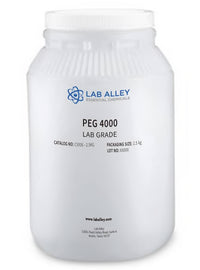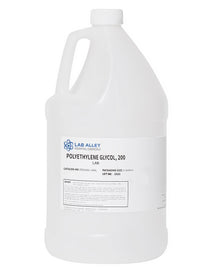Polyethylene Glycol
Food And Lab Grade PEG 400, 3350, 4000 & 8000
About Polyethylene Glycol
Polyethylene Glycol, (C2nH4n+2On+1), is synthesized by ring-opening polymerization of ethylene oxide, in which the polymer chain has a reactive element on one end that reacts with another monomer. This synthesis process gives PEG a range of molecular weights and distributions from 300 grams per mole to 10,000,000 grams per mole. PEG can be a clear, thick liquid to a waxy solid synthetic resin. Polyethylene Glycol is colorless, inert, odorless, and non-volatile. PEG is biocompatible (it won’t damage tissues or cells), hydrophilic, dissolves readily in water without changing the color odor or taste and is nontoxic.
PEG has a vast amount of uses because of its unique molecular structure. It is often used in various products and industries as a surfactant, emulsifier, cleanser, lubricant and as a carrier for pharmaceuticals. It is found in many cosmetics and products used in daily life, including toothpaste, mouthwash and breath freshener, PEG is added to help consistency and increase shelf life. It has industrial applications to soften textiles, and in detergents and cleaners. In household items it can be used to add nonstick properties and is used as a coating on large industrial products. It’s used in medicinal products as a treatment for constipation and as lubricant in veterinary applications.
Polyethylene Glycol at Lab Alley
Lab Alley has Polyethylene Glycol in the following offerings and more information on the specific uses for different concentrations can be found in the product listings below:
- Polyethylene Glycol (PEG) 400 Food Grade
- Polyethylene Glycol (PEG) 3350 USP Grade, Kosher
- Polyethylene Glycol (PEG) 4000 Lab Grade
- Polyethylene Glycol (PEG) 8000 NF Grade Kosher
Polyethylene Glycol is available in sizes ranging from 100 grams to 55 pounds for quick shipping to your facility.
Common uses and applications for Polyethylene Glycol
- Emulsifier
- Coating
- Lubricant
- Cosmetics
- Detergent
- Electronics industry
Industries
- R&D/Laboratory
- Food & Beverage
- Personal Care and Cosmetics
- Pharmaceuticals








